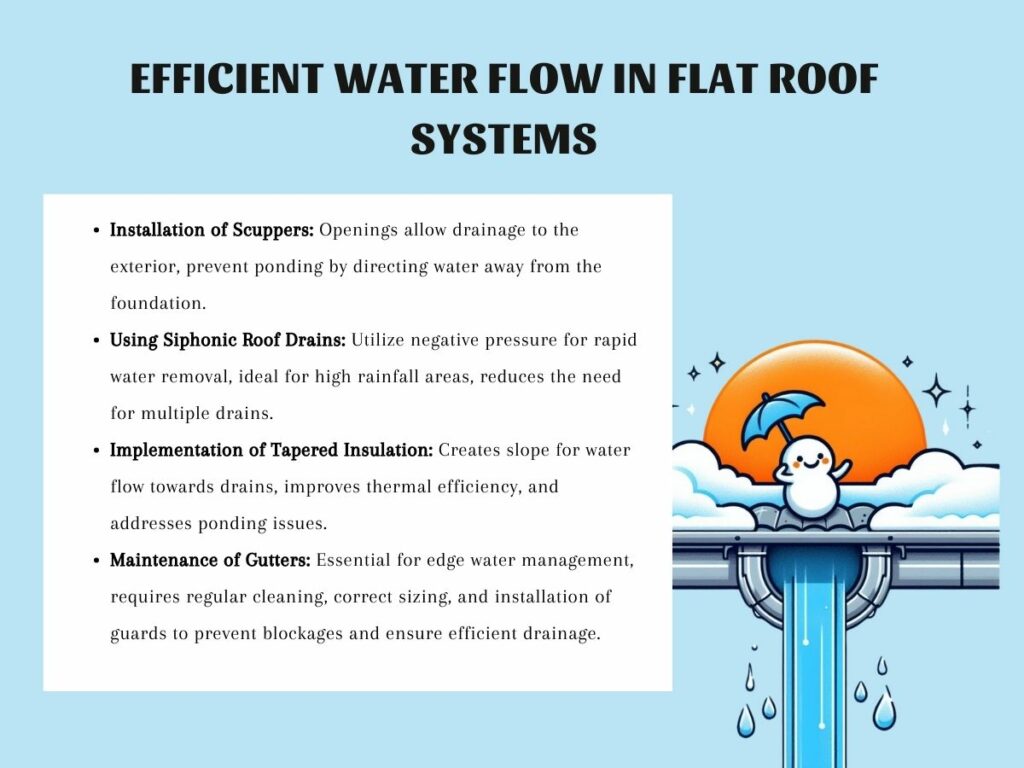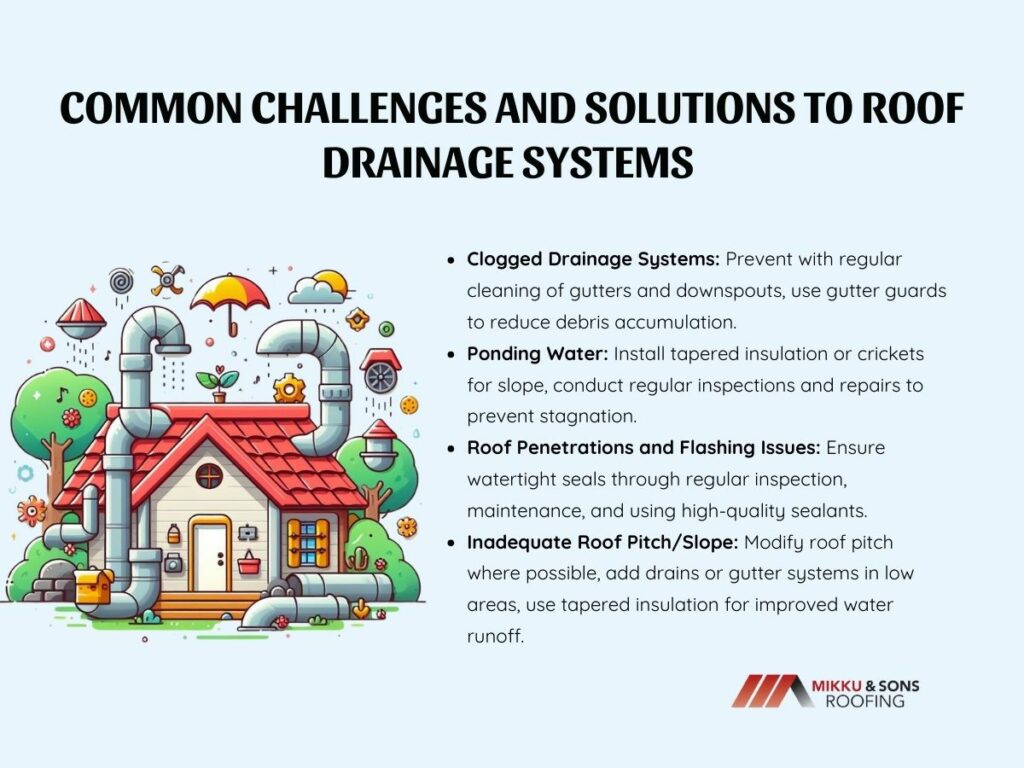

Any structure must have roof drainage systems because they are the first line of defense against structural deterioration and water damage. These systems are essential for controlling the runoff of rainfall, keeping it off the roof, and safely diverting it away from the building.
Ensuring efficient water flow in roof drainage systems is really important. Effective water drainage maintains the lifespan of the building as well as the integrity of the roof. Drainage systems are strategically designed and incorporated to disperse water from regions prone to damage.
This reduces the need for expensive repairs and guarantees the roof's durability over time. Following regulations for installing drainage systems guarantees that safety requirements are met and protects the property from possible legal risks.
Residential, commercial, and industrial buildings frequently have flat roof systems, which are distinguished by their low pitch or slope. Flat roofs have an almost horizontal surface compared to pitched roofs, which have a sharp incline that helps in water runoff.
As a straightforward and affordable roofing option, flat roofs normally consist of a membrane layer, insulation, and a structural deck.
| Drainage System | Description |
| Internal Drains | Installed within the roof surface to collect water and direct it to a drainage system. |
| External Drains | Positioned along the edges of the roof or at strategic points to channel water off the roof. |
| Scuppers | Openings in the parapet wall or roof edge that allow water to drain from the roof surface. |
| Siphonic Roof Drains | Advanced drainage systems that use negative pressure to draw water at high velocities. |

Scuppers are openings in the parapet wall or the edge of the roof that allows water to drain from the roof surface to the exterior and serve as essential outlets for rainwater runoff, minimizing the risk of ponding. They are typically fitted with downspouts or pipes to direct water away from the building's foundation.
Scuppers should be strategically positioned along the roof's perimeter to facilitate uniform water distribution and prevent localized pooling. Additionally, the size of the scupper openings should be proportionate to the roof area and anticipated rainfall intensity to prevent overflow and ensure efficient water flow.
With the use of a network of pipes and specially engineered drain heads, siphonic roof drains generate a suction that draws water off the roof and into the drainage system. Siphonic drains work by drawing water down the drainage pipes at rapid speeds using negative pressure, as opposed to standard drains that depend on gravity.
Siphonic drains are especially useful in regions with excessive rainfall or expansive roof areas where conventional drainage techniques would not be enough due to their high flow rates. Additionally, they can simplify the entire drainage system design and installation procedure by lowering the number of drain points that are needed on the roof.
The tapered insulation directs water toward specified drainage locations, which is intended to create a little slope on the flat roof surface. It is a good way to deal with places where water pools and also enhances the building's thermal efficiency and water flow efficiency through the roof.
Tapered insulation systems work well with various roofing materials and can be tailored to meet the unique needs of the roof.
Gutter problems are common despite their important function; these can range from jams from leaves and debris to sagging from heavy snowfall or rainfall. Water penetration and structural damage are less likely when gutters are constructed and maintained properly, preventing water from building up along the roof's edges.
Gutter guard installation is one way to stop debris accumulation; other solutions include ensuring the pitch is right for water flow and fixing leaks and damage immediately. Downpipe installation and sizing must be done correctly to guarantee unrestricted water flow and avoid backups or spills.
Sloped roof systems are designed with a pitched or angled surface that allows for natural water runoff. The angle or pitch determines the roof's slope, which dictates the rate at which water drains off the roof surface.

The primary function of a sloped roof is to provide a protective barrier against environmental elements, including rain, snow, and debris. The angled design of sloped roofs allows water to flow downhill, away from the roof surface, reducing the risk of water infiltration and damage to the building structure.
Roof crickets, also known as saddles or diverter roofs, are ridge-like structures installed on the roof surface to redirect water away from problem areas such as valleys, chimneys, or equipment. They are typically constructed with a slope that directs water towards drainage points, preventing water from pooling in low-lying areas and facilitating smooth water flow.
The design of the roof slope plays a crucial role in facilitating efficient water flow in sloped roof systems. The pitch or slope of the roof determines the direction and speed at which water flows off the roof surface.
Roof slopes are typically designed to comply with local building codes and standards, ensuring adequate drainage capacity based on roof size, rainfall intensity, and roof pitch. Proper slope design promotes gravitational flow, allowing water to drain away from the roof and prevent water accumulation naturally.
Grates and covers are integral components of roof drain systems, helping to prevent debris, leaves, and other materials from entering and obstructing the drainage system. Properly selected grates and covers should be compatible with the type of drain system and roof design, ensuring efficient water flow while providing protection against blockages.
Gutters and downspouts are essential components of sloped roof drainage systems, collecting rainwater from the roof surface and directing it away from the building foundation. Downspouts are vertical pipes that direct water from the gutters to the ground or drainage system, whereas gutters are normally located along the roof's eaves.
Properly sized gutters and downspouts are essential conduits for transporting collected rainwater from the roof to designated drainage points, such as downspouts or stormwater systems. Proper installation and sizing of drainage pipes are critical to ensure unrestricted water flow and prevent backups or overflows.
Valleys, where two roof planes intersect, are vulnerable areas prone to water accumulation and leaks. Valley flashing, typically made of metal or waterproof membrane, is installed along the valleys to direct water away from these areas and prevent water infiltration.
Ridge ventilation systems are installed along the ridge of the roof to promote airflow and prevent moisture buildup in the attic space. Proper ventilation helps control temperature and humidity levels to lower the chance of condensation and moisture-related problems like mold development and wood rot.
Ridge vents allow warm, moist air to escape from the attic while drawing in cooler, drier air from the exterior, promoting efficient airflow and preventing moisture buildup.
The choice of roofing materials greatly impacts the effectiveness of water flow in systems with sloped roofs. Premium roofing materials are made to effectively shed water and fend off water intrusion, including metal panels, asphalt shingles, and tiles.
For long-term durability and to stop water intrusion, roofing materials must be installed correctly, including overlapping seams and appropriate flashing details.
Efficient water flow in roof drainage systems is crucial for maintaining the integrity of the building structure and preventing water-related damage as discussed above. However, various challenges can arise that hinder the effectiveness of these systems.

Debris, such as leaves, twigs, and sediment, can accumulate in gutters, downspouts, and drains, obstructing the flow of water and causing backups. This can be prevented through regular maintenance.
This includes cleaning gutters and downspouts at least twice a year, especially after heavy storms or during the fall when leaves are prevalent. Installing gutter guards or screens can help prevent debris buildup while still allowing water to flow freely.
Ponding water occurs when water collects and remains stagnant on the roof surface, leading to structural damage, leaks, and mold growth. Installing tapered insulation or crickets helps create a slope that directs water toward drainage points.
Regular inspections to identify low spots or debris accumulation and prompt repairs or adjustments can prevent ponding. Considering roof slope during initial design or renovation can also minimize the risk of ponding.
Roof penetrations such as vents, chimneys, and skylights, along with flashing details, are vulnerable areas where water can infiltrate if not adequately sealed. This can be curbed through regular inspection and maintenance.
Checking for signs of deterioration or damage and resealing or replacing flashing as needed ensures watertight seals. Using high-quality sealants compatible with roofing materials and following manufacturer guidelines for installation helps prevent leaks around penetrations.
Insufficient roof pitch or slope can hinder water drainage, leading to ponding and water infiltration, particularly in flat or low-slope roofs. Modifying the roof pitch or slope, where feasible, improves water runoff.
Installing additional drains, scuppers, or gutter systems in low-lying areas facilitates drainage. Tapered insulation can also be added to create a slope and promote water flow.
Even the most well-planned roof drainage systems may become useless if gutters are ignored. Debris accumulation in gutters can disrupt the water's natural flow, causing leaks and backups and even damaging the building's interior and roof.
It is, therefore, essential to have a profound awareness of the importance of gutter maintenance in addition to knowing how to guarantee appropriate water flow in roofs. Over time, proactive gutter maintenance can save property owners a great deal of money, time, and distress.
Thus, even while it's important to understand how to make sure that water flows through roofs effectively, gutter care is just as important for maintaining the health of your roof.
